Since my EagleEye 5X came used, I cannot tell what should be included in the original package. In the package that I received, it includes the 5X lens, front cap, and a 28-37mm step-up ring (below left). It has no difficulty in mounting the lens on to a 950/990/995 and 4500 (below right).
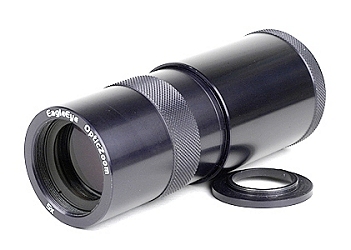
|
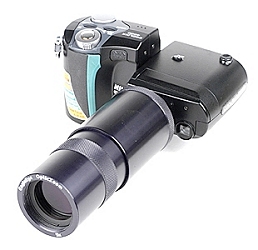
|
The front glass element of the EagleEye 5X is large. In the image below, from left to right, the lenses are EagleEye 5X, CrystalVue 8X, Nikon TelescoMicro ED6 × 18D and Kenko 6X. Note that a lower magnification requires a smaller front glass element. Judged by the size of the front glass element, the EagleEye 5X gathers more light and permits the use of larger aperture.

The left and right images below show the length of each lens focused at infinity and minimum focus length, respectively. The EagleEye 5X extends about 4mm, and takes 3/4 turn to focus from the minimum distance to infinity. Moreover, its focusing ring is not very stiff, although it is not as smooth as that of the Nikon TelescoMicro ED6 × 18D. On the other hand, the EagleEye 5X is larger and heavier than the CrystalVue 8X. Compared with the Nikon TelescoMicro ED6 × 18D and Kenko 6X, the EagleEye 5X looks like a "giant"!
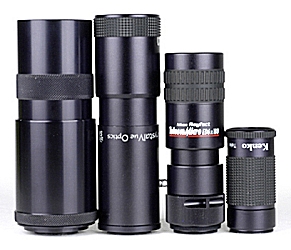
|

|
Of these monoscopes, the Kenko KUT632 and Nikon TelescoMicro ED6 × 18D come with tripod mounts in US models. CrystalVue 8X may have one but it is difficult to find, and the Kenko 6X does not need one because it is small. The EagleEye 5X does have a tripod mount; but, it is sold separately and is quite expensive. Without a tripod mount, using the EagleEye 5X on a 4500 mounted on a tripod is a scary thing. It is scary not because the lens may break the swivel body. It is because a dangling lens cannot help take sharp images. So, I try my Bogen 3420 telephoto lens support as shown below. Fortunately, it works fine although the setup looks odd. This telephoto support also works with CrystalVue. The only problem is that the lens and camera must be twisted to one side to make the lens rest on the support. Then, the support is mounted on a tripod. Yes, I still can focus.

|
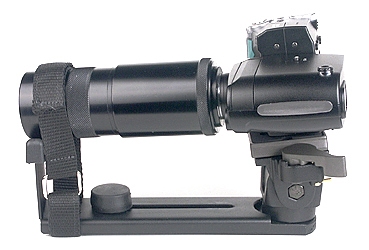
|
The first comparison is for distant scene. The following images were taken in a late afternoon with the scene a couple of hundred yards away. The yellow frames indicate the center and lower-right corner for comparison. Since the CrystalVue is a 8X monoscope that covers a much smaller area than the other two, the corner comparison may not be fair; however, one can certainly compare the EagleEye 5X and Kenko 6X without any problem. The shooting parameters are: aperture F8.2 (i.e., aperture-priority mode), matrix metering, shutter speed - which is determined by the meter - 1/153 sec (CrystalVue 8X), 1/102 sec (Kenko 6X) and 1/186 sec (EagleEye 5X), and Auto white balance). The shutter speed gives us a sense of light loss. The shutter speed when the EagleEye 5X was used, as mentioned above, was 1/186 sec, which is about 20% faster than that used by CrystalVue 8X (i.e., 1/153 sec). The CrystalVue is about 50% faster than the Kenko 6X, and, as a result, the EagleEye 5X is nearly one stop faster than the Kenko 6X.
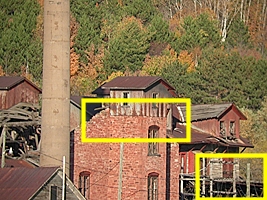
|
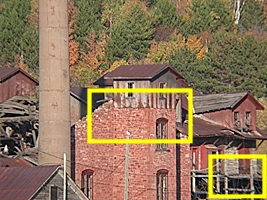
|
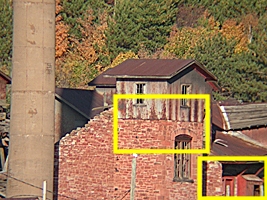
|
| EagleEye 5X (F8.2, 1/186 sec) | Kenko 6X (F8.2, 1/102 sec) | CrystalVue 8X (F8.2, 1/153 sec) |
| Click here to download the ZIP file of the original images (3,447KB) | ||
The following are the 100% crop from the center area. It is clear that CrystalVue 8X and EagleEye 5X both deliver sharp results with the Kenko 6X being a little behind. Because of higher magnification of the CrystalVue 8X, its image reveals more details, and the wavy texture of the siding of the top portion can be seen. Compared the EagleEye 5X with the Kenko 6X, the latter's image is a little blurred, especially around the windows and vertical bars. In terms of tonality, CrystalVue and EagleEye produce warmer images that reflect the setting sun, although it is slightly warmer than the actual scene. On the other hand, the image by Kenko 6X is a little cold, which is not the case in reality. A special characteristic of the CrystalVue 8X is the tendency to have a touch of blue/violet. This is also shown in its image.
| EagleEye 5X | 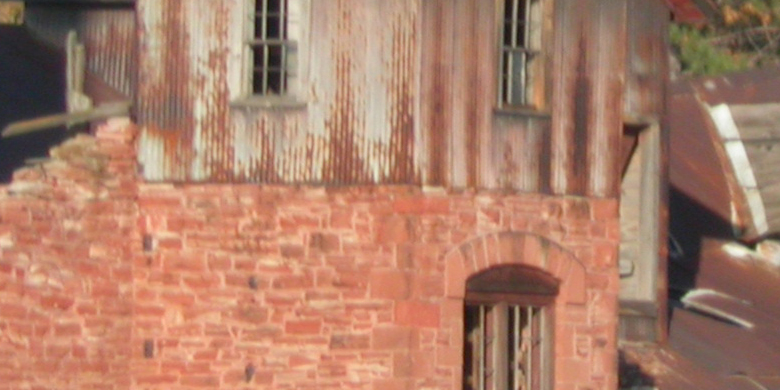
|
| Kenko 6X | 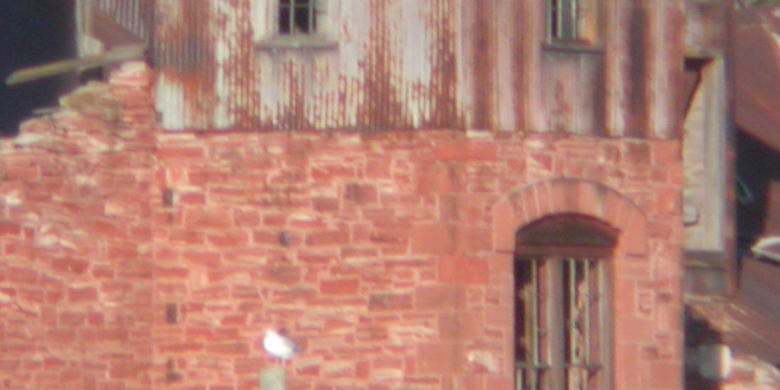
|
| CrystalVue 8X | 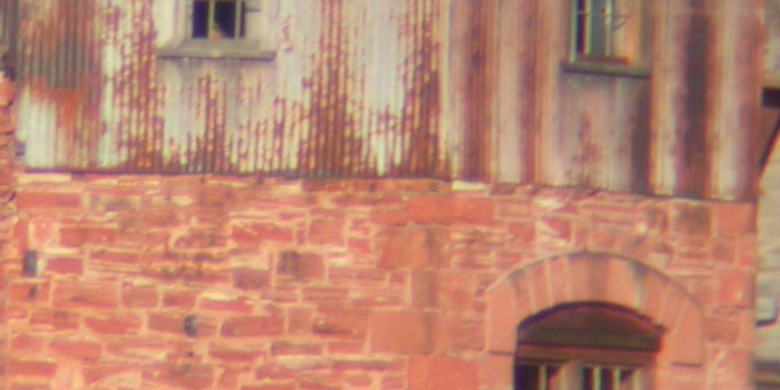
|
The following three images are 100% crops of the lower-right corner. There is no doubt that the EagleEye is the winner. The definition of each power line can be seen very clearly, and chromatic aberration is very minimal. On the other hand, the Kenko 6X performs poorly with serious chromatic aberration. We have seen this on other pages that involve the Kenko 6X. It is difficult to compare the CrystalVue and EagleEye because they have different view angles. However, in this example, it appears that the CrystalVue is not as good as the EagleEye. While some textures can still be seen, they look soft and chromatic aberration and purple fringing appear in the corner although it is much better than the Kenko 6X.
| EagleEye 5X | 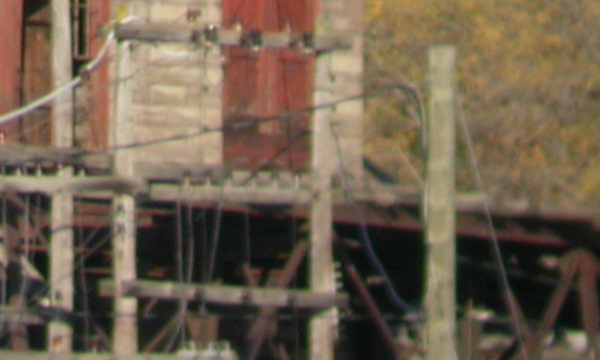
|
| Kenko 6X | 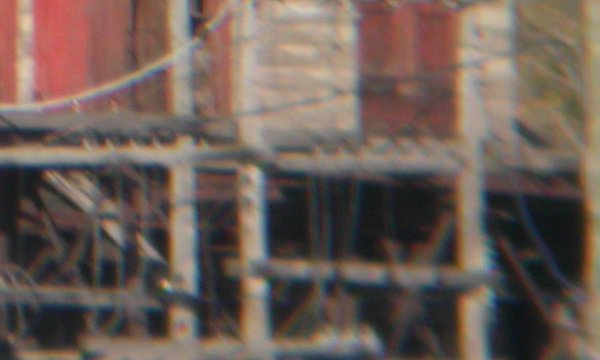
|
| CrystalVue 8X | 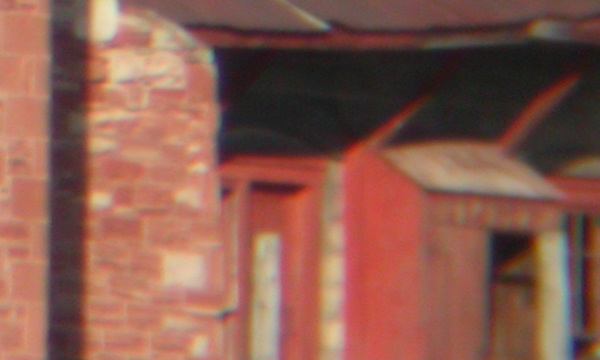
|
The following scene has a shorter subject-camera distance. It is about 200 yards away. We shall compare the three marked areas: center, left and lower left. Aperture used was F8.2.

|

|

|
| EagleEye 5X | Kenko 6X | CrystalVue 8X |
| Click here to download the ZIP file of the original images (3,447KB) | ||
The following are 100% crops of the original images that show the center areas. The results of CrystalVue 8X looks sharper and reveals more details than that of the EagleEye 5X; however, it could be the result of higher magnification of the 8X. The EagleEye 5X is crisper than the Kenko 8X, especially in the shadow areas. The Kenko 6X was not able to clearly resolve the shadow areas. Note that the Kenko 6X and CrystalVue 8X both exhibit chromatic aberration and purple/green fringing, while the EagleEye 5X has virtually no fringing problem.

|

|

|
| EagleEye 5X | Kenko 6X | CrystalVue 8X |
The following shows the 100% of the left side. The CrystalVue's crop is actually the upper-left corner, and, hence, the comparison is not entirely fair in this case. It is clear that the EagleEye is sharper and reveals more details of the roof than the Kenko 6X. On the other hand, its resolution power and more importantly contrast are lower than the other two lenses. Some purple/green fringing can be see near the left side of EagleEye's image; but, the situation is much better than the Kenko and CrystalVue. In fact, the latter always shows this type of fringing!

|

|
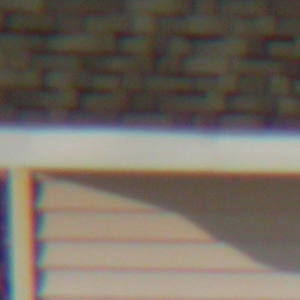
|
| EagleEye 5X | Kenko 6X | CrystalVue 8X |
The following shows the 100% crop of the window in the lower left corner. The Kenko 6X result is soft. The EagleEye 5X and CrystalVue 8X show clear and higher contrast results. However, the EagleEye 5X image seems not as good as that of the CrystalVue 8X because it has lower sharpness and lower contrast. If you reduce the CrystalVue 8X result to the same size, you will see the telephone number very clearly shown, which is much better than that of the EagleEye 5X. Of course, the CrystalVue 8X result is still good without resizing. Note that due to higher contrast, the words "FOR SALE" can be seen in the image of CrystalVue 8X. However, chromatic aberration in the 8X images is bad and very visible.
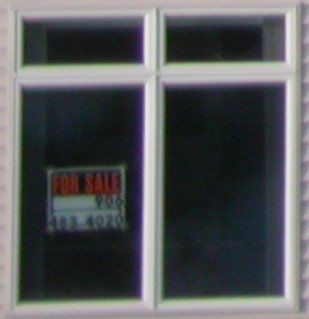
|
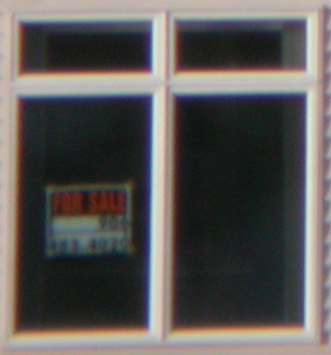
|

|
| EagleEye 5X | Kenko 6X | CrystalVue 8X |
The last test determines how good the lenses perform at the minimum focus distance of the EagleEye 5X. The following shows the images for this evaluation. All shots were taken with F8.2 and 1/8 second with white balance preset at a distance about 11 ft from the subject. The aperture and shutter speed were measured by an incident light meter and is accurate. However, since each lens reduces some amount of incoming light, the actual amount of light that can reach the image sensor is less than the meter reading. Since the aperture and shutter speed are all fixed, we will be able to see, or at least get a feeling for, how much light intensity was reduced. From these four images, it is obvious that the light loss of the EagleEye 5X is smaller than the CrystalVue, which, in turn, is smaller than the Kenko 6X. This is because the image of the EagleEye 5X is brighter than that of the CrystalVue 8X, which, in turn, is brighter than that of the Kenko 6X. Compared the brightness at the corner and center, we see that light fall-off of the EagleEye 5X is worse than the other two.
Note that we have to take two shots for the CrystalVue 8X to use the similar center and upper-left corner for comparison. The yellow frames mark the areas for comparison purpose.

|

|
|
| EagleEye 5X | Kenko 6X | |

|
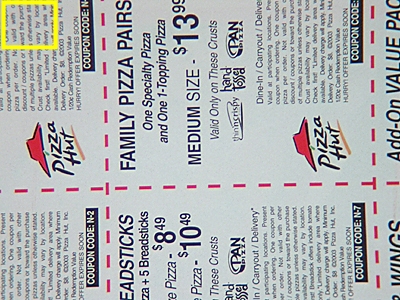
|
|
| CrystalVue 8X - Center | CrystalVue 8X - Upper Left | |
| Click here to download the ZIP file of the original images (4,319KB) | ||
The following has the 100% center crop of each image. From these images, we see that the contrast of the EagleEye 5X is not as high as that of the CrystalVue 8X. In terms of sharpness, the EagleEye 5X is better than the Kenko 6X. It must better be because the EagleEye is at least twice more expensive than the Kenko 6X. However, compared with the CrystalVue 8X, I do not see the EagleEye is better. The definition of each letter in the image of CrystalVue 8X is clearer than the results in that of the EagleEye. This may be due to EagleEye's lower contrast and/or the size of each letter is larger in the image of CrystalVue 8X.
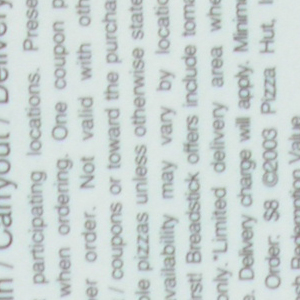
|
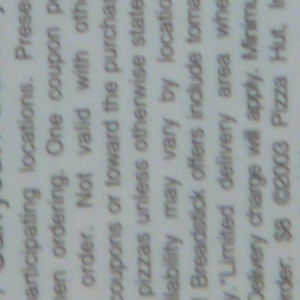
|
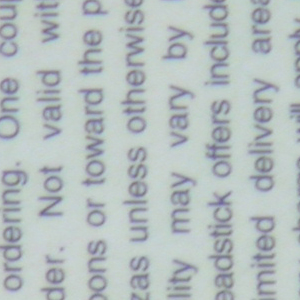
|
| EagleEye 5X | Kenko 6X | CrystalVue 8X |
The following is the 100% crop of the upper-left corner of each image. Compared these images with the center crops, it is easy to see that EagleEye has a serious light fall-off problem. In other words, the brightness difference between the center and upper-left corner is very large, larger than 1 stop. The light fall-off problem does exist for the Kenko 6X and CrystalVue 8X; however, they are not as significant as the EagleEye. In terms of sharpness, the Kenko 6X is the worst as demonstrated in many tests on this and other pages. It is interesting to point out that the EagleEye maintains a reasonably good sharpness from center to near the edge. Outside of certain area, the sharpness deteriorate quickly as shown in its upper-left image. The CrystalVue 8X performed quite well. Sharpness reduces near the corners and chromatic aberration increases; however, the sharpness difference between the center and the upper-left corner is not as large as that of the EagleEye.
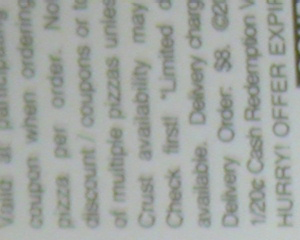
|

|
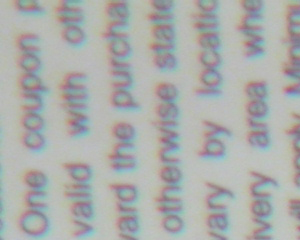
|
| EagleEye 5X | Kenko 6X | CrystalVue 8X |
Thus, in this portion of comparison, I can only rate the EagleEye 5X as good as the CrystalVue 8X because the former has serious light fall-off, lower contrast, and may-not-be high enough sharpness. However, the EagleEye does not exhibit serious chromatic aberration as we frequently see in images shot by the CrystalVue 8X.
Here is a list of my very personal findings: